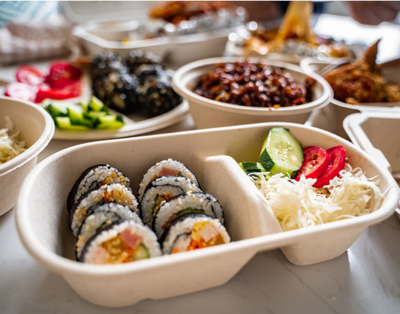One of the biggest concerns that makes customers hesitate when purchasing eco-friendly products is cost. Sustainable alternatives often come with a higher price tag compared to conventional options, especially when placed side by side on supermarket shelves.
But are these higher prices justified? The cost we see on a price tag is only the market price, while the true cost includes hidden environmental, health, and social impacts. In this blog, we’ll break down why eco-friendly products are more expensive, what hidden costs plastic-based alternatives carry, and whether sustainable choices are truly worth your money.
Why Are Eco-Friendly Products More Expensive?
To understand the pricing of eco-friendly products, we need to consider their entire lifecycle, from raw materials and production to disposal.
1. Higher-Quality, Sustainable Materials
Unlike cheap, petroleum-based plastics used for single-use items, eco-friendly alternatives like compostable straws, food containers, and utensils are made from renewable plant-based materials such as sugarcane, coffee, rice, and coconut.
-
Plastic production is mass-scaled and subsidized, making materials like PET, PP, and PS much cheaper than renewable resources.
- Sustainable materials are still relatively uncommon and require more effort to source and process, increasing production costs.
Example:
-
A plastic straw costs around $0.01, while a compostable sugarcane straw costs $0.05–$0.08 due to the material and production costs.
- However, plastic straws take 200–500 years to decompose, whereas compostable straws break down within a year in natural environments.
2. Ethical Production & Fair Wages
Many low-cost products are affordable at the expense of human labor. The fast fashion industry, for example, is notorious for poor working conditions, underpaid labor, and environmental harm.
-
Cheap products often involve unethical labor practices and exploit workers in developing countries.
-
Sustainable brands ensure fair wages, safe workplaces, and eco-conscious production methods, which naturally increase costs.
🔍 Example:
-
A $5 T-shirt made under poor labor conditions vs. a $25 organic cotton T-shirt from a fair-wage, ethical brand.
- The real cost of the cheaper option? Pollution, worker exploitation, and a short lifespan
When buying sustainable products, you’re not just paying for the item—you’re supporting ethical labor, fair wages, and environmentally responsible practices.
3. Limited Production Scale
Plastic products have dominated the market for decades, benefiting from mass production and government subsidies. In contrast, eco-friendly products are still gaining market share, which means:
-
Lower demand = Higher production costs per unit
-
Fewer factories = More expensive raw material sourcing and logistics
-
Lack of subsidies – Governments still support fossil fuel-based plastics, making sustainable alternatives appear more expensive.
The Good News? As more consumers and businesses shift toward eco-friendly options, production will increase, and costs will naturally decrease.
The True Cost of Conventional vs. Eco-Friendly Products
To make a fair comparison, let’s analyze the short-term vs. long-term costs of conventional vs. sustainable products.
|
Product |
Conventional Price |
Eco-Friendly Price |
Lifespan & Value |
|
Plastic Straws (100 pcs) |
$2.00 |
Compostable Sugarcane Straws (100 pcs) - $6.00 |
Plastic takes 200–500 years to decompose, sugarcane straws break down in 12 months. |
|
Plastic Bags (100 pcs) |
$3.00 |
Reusable Tote Bag - $5.00 |
A tote bag lasts for years, reducing waste and recurring costs. |
|
Plastic Food Containers (50 pcs) |
$10.00 |
Sugarcane Food Containers (50 pcs) - $20.00 |
Plastic containers remain in landfills for centuries, sugarcane containers compost in 90–180 days. |
While plastic products seem cheaper at checkout, they have hidden environmental, health, and disposal costs.
How to Find Affordable Eco-Friendly Products
You don’t have to spend a fortune to be sustainable! Here are smart ways to cut costs:
- Buy in Bulk: Brands like EQUO offer discounts on wholesale orders.
- Choose Reusables: Tote bags, bamboo utensils, and metal straws cut recurring costs.
- Support Local & Ethical Brands: Local products reduce transportation costs and have a smaller
- Look for Promotions & Discounts: Many sustainable companies offer seasonal sales, loyalty rewards, and referral discounts.
Are Eco-Friendly Products Worth It? The Verdict
Higher Initial Price, Greater Long-Term Value: Sustainable products last longer, reduce waste, and are healthier for you and the environment.
Plastic Waste is Costly: The hidden costs of plastic pollution, waste management, and health risks far outweigh the short-term savings of cheap plastic products.
Sustainable Business = Smart Business: Companies investing in eco-friendly alternatives stay ahead of regulations, improve brand image, and attract eco-conscious consumers.
Final Thoughts: Make the Smart Choice Today
Switching to eco-friendly products isn’t just about spending money, it’s about investing in a healthier, cleaner future. The true cost of plastic is far greater than what we see at checkout. By choosing sustainable alternatives, you’re making a difference for yourself, your wallet, and the planet.


